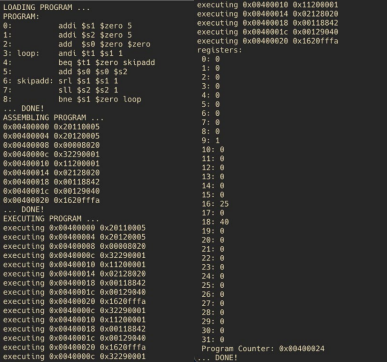Week 22/24 Assessed Coursework
Week 22/24 Assessed Coursework
C/DEBUGGING
Deadline Friday Week 24 (14/5/21, 16:00)
In week 20, you worked on the task of implementing a C function which translates MIPS assembly code into bytecode. You task for the SCC.150 week 24 coursework is to extend the code and implement an exec_bytecode function, to complete your MIPS CPU emulator. The function should read the bytecode generated by the make_bytecode function and stored in the integer array text. Your program should unmarshal 32-bit instructions and modify appropriately the state of the registers contained in the registers integer array and the pc global variable. Your implementation should support the following instructions:
NOP - no operation, ADD - addition, ADDI – addition immediate ,
ANDI - bitwise immediate and, SRL - shift right logical, SLL - shift left logical,
BEQ - branch on equal, BNE - branch on not equal
Your implementation should manipulate the pc register value and emulate addresses in the text memory area (0x00400000 – 0x1001000, start from address 0x00400000) and should provide a way to terminate the execution of a program (e.g. nop instruction).
Important notes:
• Marks will be awarded only for the exec_bytecode function implementation and any new functions that you will define/implement to improve code readability.
• You should use the update template, which can be found at https://modules.lancaster.ac.uk/draftfile.php/465779/user/draft/55386476/emulator_w24. zip to implement your solution, which contains a correct implementation of the make_bytecode code.

Figure 1 Output of the MIPS emulator when running the Ethiopean multiplication algorithm with input the number 5 and 5.
Marking Scheme
|
Aspect
|
Weighting
|
|
Functionality
|
60%
|
|
Code elegance, clarity, organization
|
30%
|
|
Self-marking
|
10%
|
Functionality
|
A+
|
Registers are handled correctly in all cases, there is a method to terminate the
program, the emulator executes correctly complex MIPS programs.
|
|
A
|
The program can parse and execute branch instructions.
|
|
B
|
I-type instructions are correctly parse and executed (addi, andi).
|
|
C
|
R-type instructions are correctly parsed and executed (add, srl, sll).
|
|
D
|
Program is read from the int array, a loop is implemented to execute the program
(program counter is used), code is executed based on instruction opcode and func
fields.
|
(*) This is an example of a marking scenario and marks are awarded proportionally for each functionality. If you code only implements the addi and andi insutrctions and a simple loop, then you will get a C.
Comments/clarity/organization
|
A
|
Clear structure (and helpful comments) about variable use. Well commented
throughout. Spaced and organised for clarity. Appropriate use of function to organize
code.
|
|
B
|
Good use of comments. Reasonable organisation, can follow program reasonably well.
Variable use is sensible.
|
|
C
|
Sparse or sometimes unhelpful comments. Some consistency in use of variables.
|
|
D
|
No comments. Difficult to read code.
|
Self-marking
|
A
|
Clear and concise, functionality is accurate, comments reflect marking criteria
|
|
B
|
List of mostly accurate grades, comments are there but not entirely clear or
unnecessarily long, or functionality grade is slightly off
|
|
C
|
Just a list of grades, mostly accurate (or close) but no explanation
|
|
D
|
Just a list of grades, inaccurate
|
2021-05-13
C/DEBUGGING